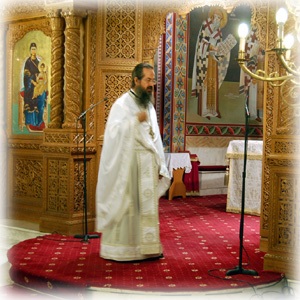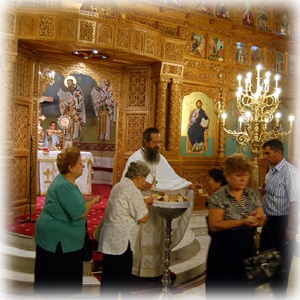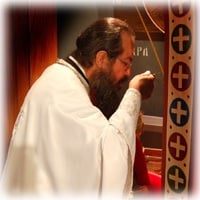Thanksgiving and Dismissal
23 February 2017The last part of the Divine Liturgy consists of the thanksgiving for Holy Communion and the Dismissal. The priest takes the chalice and paten to the Preparation Table, folds the red cloth and places the Gospel on it, while saying prayers of thanksgiving, in which the congregation take part.
 There are two brief hymns: ‘We have seen the true light; we have received the heavenly Spirit; we have found the true faith, as we worship the undivided Trinity; for the Trinity has saved us’. And: ‘Let our mouths be filled with your praise, Lord, that we may sing of your glory. For you have counted us worthy to partake of your holy, divine, immortal and life-giving Mysteries. Keep us in your holiness, that we may meditate on your righteousness all the day long. Alleluia, alleluia, alleluia’.
There are two brief hymns: ‘We have seen the true light; we have received the heavenly Spirit; we have found the true faith, as we worship the undivided Trinity; for the Trinity has saved us’. And: ‘Let our mouths be filled with your praise, Lord, that we may sing of your glory. For you have counted us worthy to partake of your holy, divine, immortal and life-giving Mysteries. Keep us in your holiness, that we may meditate on your righteousness all the day long. Alleluia, alleluia, alleluia’.
The priest then comes out before the icon of Christ on the iconostas and says the ‘Prayer behind the Ambo’, through which he asks God’s blessings on us. We then sing: ‘Blessed be the name of the Lord, from this time forth and for evermore’, three times. The priest then blesses us, invoking the supplications of the saints, particularly those whose feast it is, and Saint John Chrysostom, whose liturgy we’ve celebrated. The Divine Liturgy ends with: ‘Through the prayers of our holy fathers, Lord Jesus Christ have mercy upon us and save us’.
 The priest then hands out the antidoro. This is small pieces of the liturgical bread which were used in the Preparation and which, in the old days, were received by those who hadn’t taken Holy Communion. (‘Antidoro’ means ‘instead of the gifts’). Nowadays the whole congregation takes it, including those who have had Communion.
The priest then hands out the antidoro. This is small pieces of the liturgical bread which were used in the Preparation and which, in the old days, were received by those who hadn’t taken Holy Communion. (‘Antidoro’ means ‘instead of the gifts’). Nowadays the whole congregation takes it, including those who have had Communion.
 The priest then consumes the remnants of the Precious Gifts, wipes the Holy Chalice carefully, covers the holy vessels and places them on the Preparation Table. He reads the Prayers of Thanksgiving, removes his vestments, kisses the altar and departs.
The priest then consumes the remnants of the Precious Gifts, wipes the Holy Chalice carefully, covers the holy vessels and places them on the Preparation Table. He reads the Prayers of Thanksgiving, removes his vestments, kisses the altar and departs.






